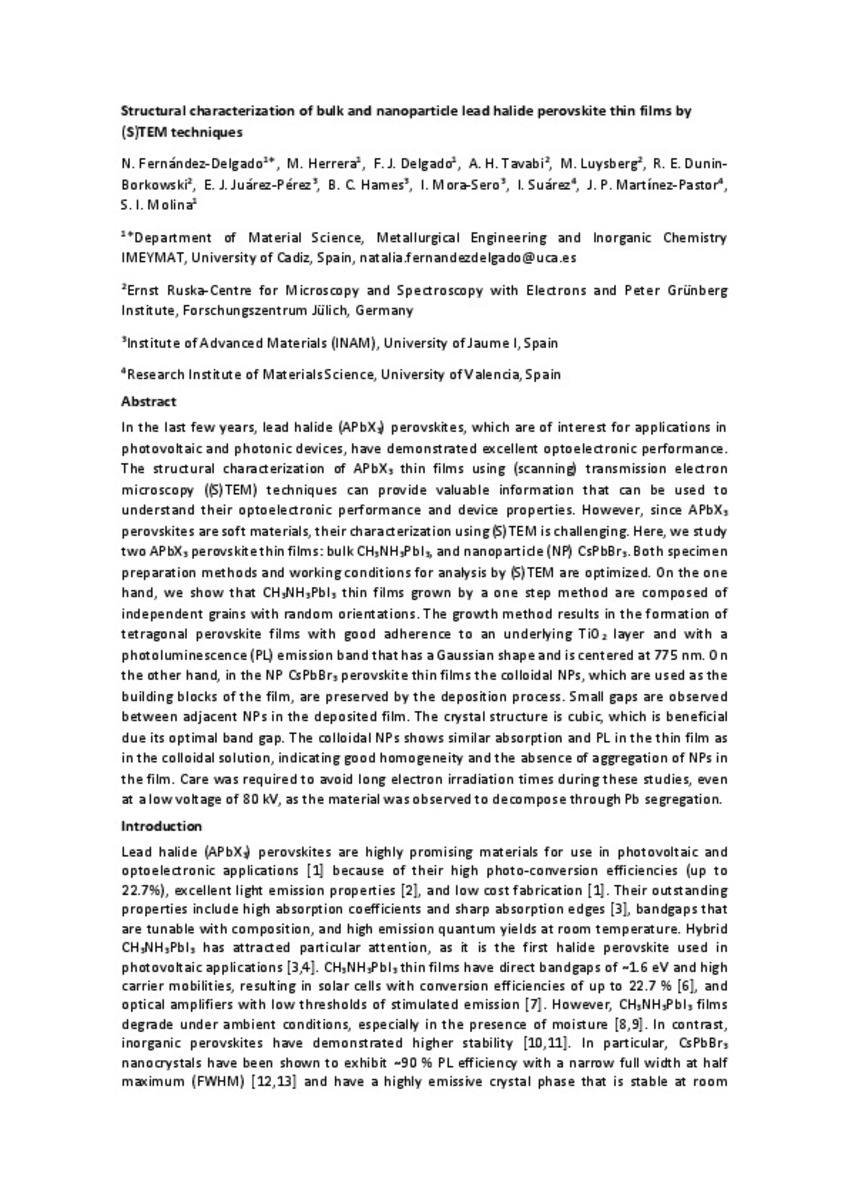Mostrar el registro sencillo del ítem
Structural characterization of bulk and nanoparticle lead halide perovskite thin films by (S)TEM techniques
| dc.contributor.author | Fernández Delgado, Natalia | |
| dc.contributor.author | Herrera, M. | |
| dc.contributor.author | Delgado, F. J. | |
| dc.contributor.author | Tavabi, Amir Hossein | |
| dc.contributor.author | Luysberg, M. | |
| dc.contributor.author | Dunin-Borkowski, R. E. | |
| dc.contributor.author | Juarez-Perez, Emilio J. | |
| dc.contributor.author | Clasen Hames, Bruno | |
| dc.contributor.author | Mora-Sero, Ivan | |
| dc.contributor.author | Suárez, Isaac | |
| dc.contributor.author | Martínez-Pastor, Juan P. | |
| dc.contributor.author | Molina, S. I. | |
| dc.date.accessioned | 2019-04-08T09:23:33Z | |
| dc.date.available | 2019-04-08T09:23:33Z | |
| dc.date.issued | 2019 | |
| dc.identifier.citation | N Fernández-Delgado et al 2019 Nanotechnology 30 135701 | ca_CA |
| dc.identifier.issn | 0957-4484 | |
| dc.identifier.issn | 1361-6528 | |
| dc.identifier.uri | http://hdl.handle.net/10234/182248 | |
| dc.description.abstract | Lead halide (APbX3) perovskites, in polycrystalline thin films but also perovskite nanoparticles (NPs) has demonstrated excellent performance to implement a new generation of photovoltaic and photonic devices. The structural characterization of APbX3 thin films using (scanning) transmission electron microscopy ((S)TEM) techniques can provide valuable information that can be used to understand and model their optoelectronic performance and device properties. However, since APbX3 perovskites are soft materials, their characterization using (S)TEM is challenging. Here, we study and compare the structural properties of two different metal halide APbX3 perovskite thin films: bulk CH3NH3PbI3 prepared by spin-coating of the precursors in solution and CsPbBr3 colloidal NPs synthetized and deposited by doctor blading. Both specimen preparation methods and working conditions for analysis by (S)TEM are properly optimized. We show that CH3NH3PbI3 thin films grown by a one-step method are composed of independent grains with random orientations. The growth method results in the formation of tetragonal perovskite thin films with good adherence to an underlying TiO2 layer, which is characterized by a photoluminescence (PL) emission band centered at 775 nm. The perovskite thin films based on CsPbBr3 colloidal NPs, which are used as the building blocks of the film, are preserved by the deposition process, even if small gaps are observed between adjacent NPs. The crystal structure of CsPbBr3 NPs is cubic, which is beneficial for optical properties due to its optimal band gap. The absorption and PL spectra measured in both the thin film and the colloidal solution of CsPbBr3 NPs are very similar, indicating a good homogeneity of the thin films and the absence of aggregation of NPs. However, a particular care was required to avoid long electron irradiation times during our structural studies, even at a low voltage of 80 kV, as the material was observed to decompose through Pb segregation. | ca_CA |
| dc.format.extent | 13 p. | ca_CA |
| dc.format.mimetype | application/pdf | ca_CA |
| dc.language.iso | eng | ca_CA |
| dc.publisher | IOP Publishing | ca_CA |
| dc.relation.isPartOf | Nanotechnology, 30, 2019. | ca_CA |
| dc.rights.uri | http://rightsstatements.org/vocab/CNE/1.0/ | * |
| dc.title | Structural characterization of bulk and nanoparticle lead halide perovskite thin films by (S)TEM techniques | ca_CA |
| dc.type | info:eu-repo/semantics/article | ca_CA |
| dc.identifier.doi | https://doi.org/10.1088/1361-6528/aafc85 | |
| dc.relation.projectID | TEC2014-53727-C2-1-R ; TEC2014-53727-C2-2-R ; TEC2017-86102-C2-2-R ; TEP-946 | ca_CA |
| dc.rights.accessRights | info:eu-repo/semantics/openAccess | ca_CA |
| dc.relation.publisherVersion | https://iopscience.iop.org/article/10.1088/1361-6528/aafc85 | ca_CA |
| dc.type.version | info:eu-repo/semantics/submittedVersion | ca_CA |
Ficheros en el ítem
Este ítem aparece en la(s) siguiente(s) colección(ones)
-
FCA_Articles [501]
Articles de publicacions periódiques -
INAM_Articles [506]







